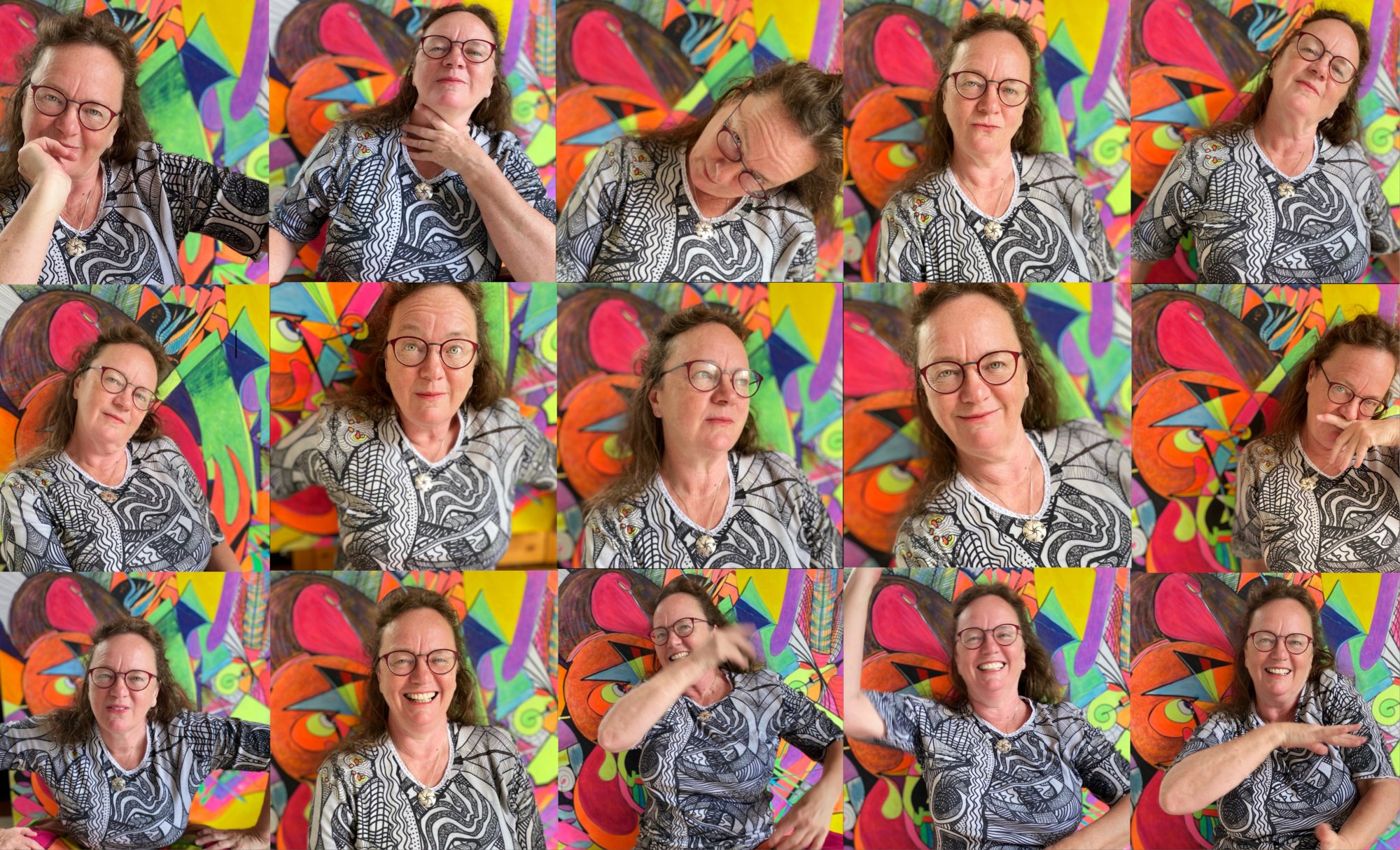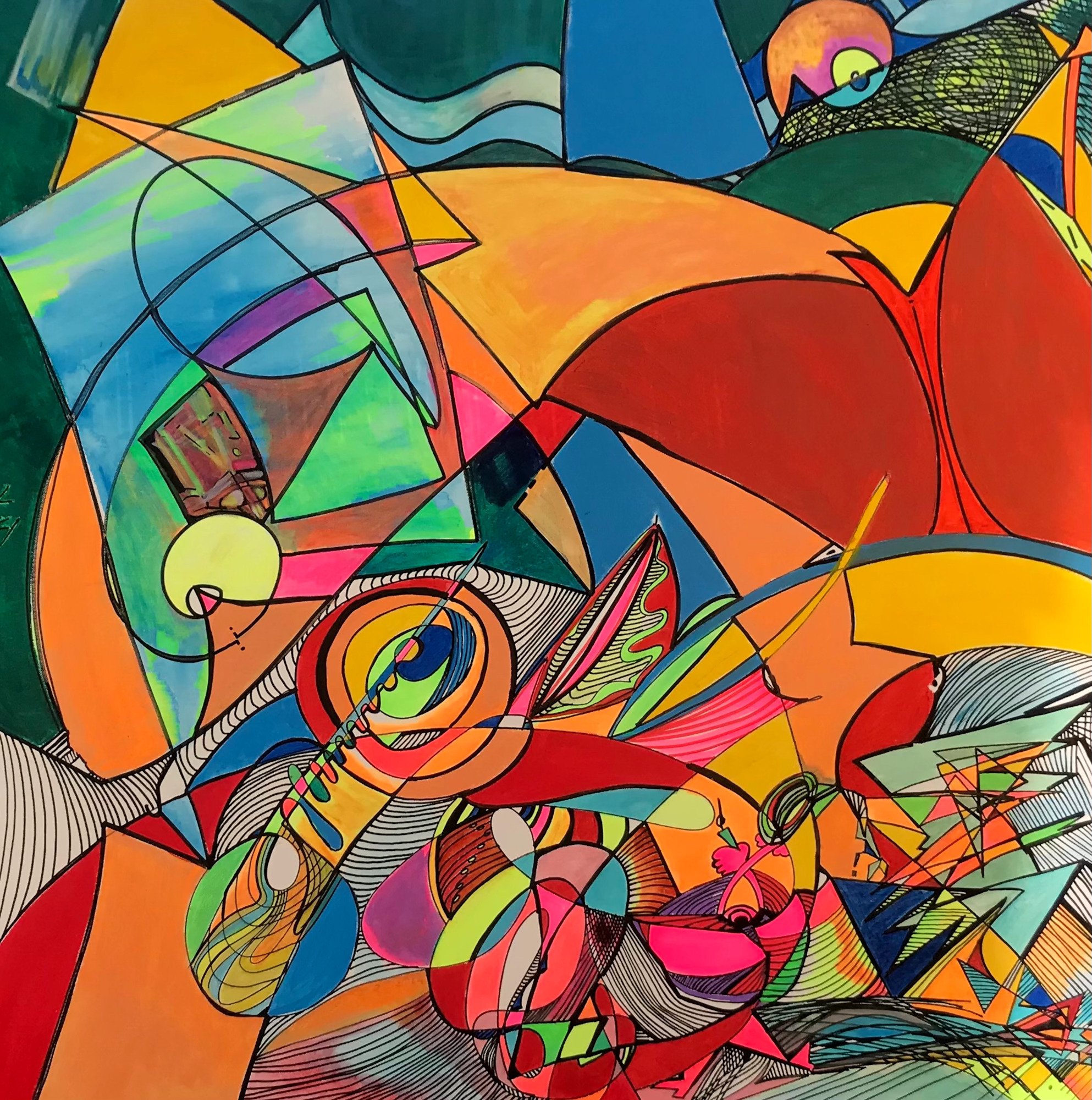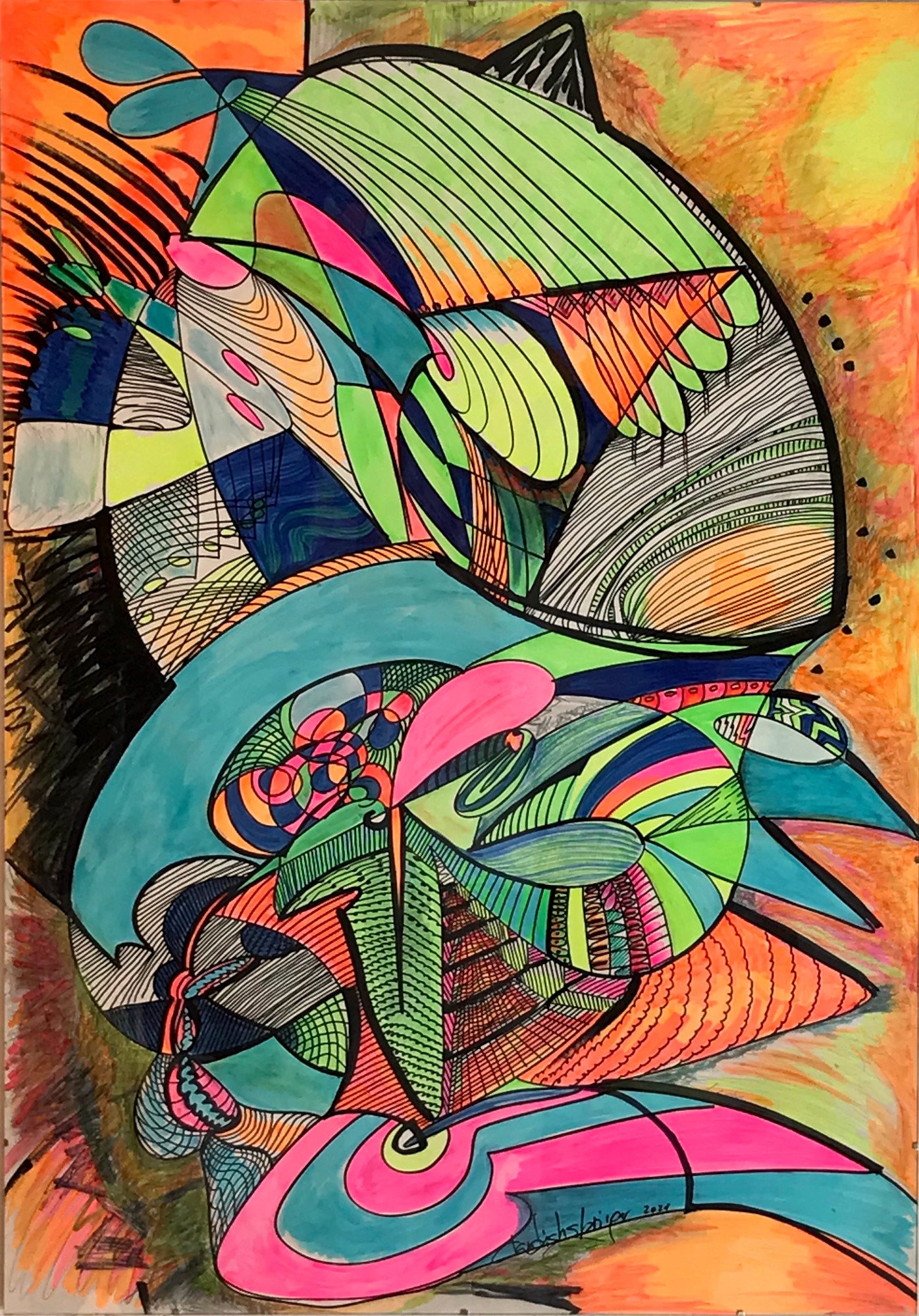10 Questions with Claudia Habringer
Claudia Habringer wanted to go on stage first. She received her training as a musical actress at the musical school at the Theater an der Wien. Soon after she graduated, she discovered that her talents lay elsewhere. She enjoyed working with people more and accompanying them in their life and development. Singing, dancing, and acting were very useful in all of her seminar projects. She worked with a large variety of target groups dealing with children in kindergarten or school, disabled and blind people, professional therapists and teachers, managers, and finally, refugees.
One soft spot became her passion for energy fields and alternative healing methods. Her sensitivity helped her delve deeper into context. This ability was particularly beneficial for projects involving people with special needs. Perceiving the other person as an overall concept is very important to her. The next step in her art life offered itself at an exhibition of a friend. She performed the exhibited paintings through voice improvisation and dance. This was her first cross-over experiment. She wanted to show that artworks do have their own spirit and that they are more than just canvas and paint. On this very day, her Art Of Resonance was born. She started to explore different kinds of possibilities to draw what she perceived. Her artworks seemed to evolve themselves.
Claudia never allowed herself to be classified and did not ask her students to do so. All that matters is the dedication to the freedom to create. Recently she found one of her drawings when she was three years old and realized it had been all there already. Through years of living and exploring, she just had to learn that art needs freedom to express itself. There is a new "baby" now. She redesigns her artworks for fabric prints.
Claudia Habringer - Portrait
ARTIST STATEMENT
She understands her works as blueprints of her perceptions. Colors and lines spill onto the canvas. The markers she uses create dimensions, whereas the colors express feelings. Wherever you place the artworks, they have an impact on that very space.
When she was asked to illustrate a poem, the process itself created an inner movie of life sequences. It is never the poem itself, but all that led to it—the person who wrote it, the circumstances that led to it, inner conflicts, past and present, and even the future. It is always the journey that interests her, which can be a never-ending story.
Imagine you have to illustrate just one tone. The mind can never do it, but becoming the tone and having the guts to let the tone draw itself can work. The same procedure works with all of her drawings. Mozart, for example, created a childlike and playful inner state by appearing in a line composition on fabric. "The 36" expresses a look behind the scenes—another journey from the end of the universe to the cell nucleus.
She has been interested in energy fields for quite a long time. Perception of the aura has become a part of her life. It is always a journey starting at a dot. She focuses on staying connected with the targeted field as long as the creative process lasts. The variety of endless possibilities had her draw healing plants of the druids, classical composers, friends, music, painters, writers, poets, countries, healing methods, trees, loved ones, planets, or the sun.
The amazone, marker and acrylic on canvas, 100x80 cm, 2020 © Claudia Habringer
INTERVIEW
First of all, tell us how you started your art career. You trained as a musical actress; how and when did you start getting involved with visual arts?
I have to admit I think art found me and grew up with me. As a child, I was always allowed to leave my toys lying around and didn't have to clean everything up straight away. It was my chaotic hideout shared with my brother. I've created worlds with chunks of wood, Lego bricks, real bricks I found somewhere, newspaper patterns, and God knows what else. What happens in video games today, I created in my head.
I think we all have a plan in our lives that we once chose. It doesn't reveal itself immediately, and it's definitely not a straight line. I can say that much after 58 years. I must have tried every creative plan I could think of - first the stage as a performing artist, in between a bit of radio and film, and the work as a trainer and coach. At some point, I started painting. I was working with oil pastels on paper and painting on silk when my life decided to become a trouble spot, challenging me to take a different direction. I was more interested in energetic and systematic healing than anything else. Art had to wait again. However, I have learned a lot about the systemic connections within and around us during this time. I've always been curious, so it's not surprising that I was more interested in the connections between all things that exist and things that no longer exist to our eyes.
My empathy was also sharpened, and I was open to new things. Like pieces in a jigsaw puzzle, the visual arts began to fit together.
My musical and vocal improvisations, dance, sensitivity to energy fields, and interest in the bigger picture began to merge in the visual arts I now work with. It became the "Art Of Resonance" and visual arts grew up with me.
Inner balance, marker on paper, 70x100 cm, 2021 © Claudia Habringer
How has your art evolved over the years?
When I started Art of Resonance around 2015, I merely used lines and fewer colors. At that time, I liked to immerse myself in the realms of famous composers who had passed away, such as Beethoven, Mozart, Bach, Vivaldi, and many others. Their legacy lives on in the form of their work, and I wanted to make that visible. I chose markers because when I close my eyes to meditate on the targeted field, what I perceive shows up as vibrational patterns. These can be loops or lines with rough edges, and that's where I'd start. Throughout the process, I try to turn my mind off as much as possible. The markers can also be used to clearly define levels or draw directions for the eye, which can then disappear into nothing or run away in a completely different direction. Some drawings can be looked at for a long time to explore all the details. If the spectators allow themselves to perceive the artwork as a whole, that is, to become the artwork themselves, they have done what I do in reverse order.
The process hasn't changed over the years, but the tools have. After some time with coated fabrics measuring 60x300 cm or a little smaller, I switched to framed canvas or canvas board, mostly working on square patterns.
The most recent work was an illustration of a Portuguese poem. I don't speak Portuguese, but the sound of the words is enough to connect me to the poem and its creator and then just let it flow out of me. The topics always find me at a point in time that suits their origin. So it can be understood that I suddenly feel the need to deal with a certain topic. Sometimes there is the need to resonate with a special healing plant, or some friend wants to know how they look on canvas, or I get the crazy urge to grasp a vintage tie and perceive the person who wore it last to make his energetic remains visible. I know that is a little bit odd, but I love odd to be understood as very much individual.
To answer your question, the evolvement was rather the underlying theme of my works over the years. They got more complex, just like this poem, which is an end product of what has been experienced and more or less processed over the years.
How would you define yourself as an artist, and what is your personal aim?
As the one who has tried many art forms, I feel comfortable now. I can express myself in many forms. I enjoy perceiving life in its diversity, complexity, and yet simplicity. The expression of the body is important because it reflects dynamism. The intense perception helps to get in touch with the essential, my work as a language trainer brought insights into different cultures and opened up a realm of connections for me, where you will find yourself in my artworks. They become visible as colors and symbols, and everyone can read for themselves again and be able to if they engage with their own abilities. So the definition of me as an artist has to be that I'm a tool of something bigger, and I love it.
My personal goal is to continue exploring things the way they are meant to be done and be honest with myself and others in my work.
In resonance with a friend, marker and acrylic on canvas, 50x50 cm, 2020 © Claudia Habringer
In resonance with JAZZ music, marker on canvas, 50x50 cmm 2019 © Claudia Habringer
In resonance with the Guggenheim Museum NY, marker and acrylic on canvas, 100x100 cm, 2021 © Claudia Habringer
In resonance with Sage, Marker on canvas board, 50x50 cm, 2018© Claudia Habringer
What is your creative process like? Where do you draw inspiration from, and how do you translate it into your work?
Like a sort of channel that leaves no room for the head, leaving the choice of pen and color to intuition and inspiration at the time of creation, the translation comes when it's all over, and the work is done. But sometimes, it happens that inner images and emotional states arise in me during the creation process. For example, when I was drawing the lines of Mozart, I felt like I had to play all the time and was super excited. While J.S. Bach only got cubes and squares out of me. However, I drew them from a 90-degree rotated perspective.
Some symbols were repeated, and I wanted to learn more about people's lives. In the end, I think you have to feel them instead of reading them. Every day our brain is confronted with a variety of information that the brain has to process. The interpersonal sensors suffer greatly, and they are oppressed. At the moment, I'm wondering how blind people would perceive my artworks. Colors are vibration units and are therefore used, for example, in color therapy. This is how ideas for new projects come about. An exhibition for blind and sighted people and exchange about what is perceived. This also brings me to the question: "Have you ever tried to feel a space in a museum, especially what a work of art does to your body, for example, when you look at it?" You can translate the image into motion or even dance if you go all in. Now I step on the toes of all those who have to dissect art down to the last detail. That's fine too, just not my approach.
Your work uses bright colors and striking lines. What message do you want to convey?
With my approach to life and my approach to fine arts, I have to question the nature of the message to find out why it shows up the way it does. However, I have to say that colors have always been important in my life. I love colorful fashion designs and things that are different from the mainstream.
As an actress, of course, I learned to appear on stage, and that requires presence. Strong colors convey this. That reveals my presence in the artworks.
In resonance with an African Music Festival, marker and acrylic on canvas, 80x100 cm, 2020 © Claudia Habringer
How did you come up with this idea, and how do you choose the colors to use?
The colors seem to choose themselves. I mainly sit on the ground in the middle of all the markers I possess, and those who are popping out are those who need to be taken. In the meantime, after several years of practice, I know what color needs to go where. The lines and the fields go first, and then I fill the area with the colors. I use acrylic only with big fields.
What is the most challenging part about creating your art?
Three things challenge me. The first is the confidence that it will work out well. Ultimately, it does. None of my artworks are pre-sketched, and I haven't painted over any of about 150 artworks to date. The second is to maintain a connection with the target object. The artworks are not created in a single session. I need to reconnect when I sit down again. The third is to properly disconnect. Otherwise I'll act as an energy field bucket, which wouldn't be so good.
What you see is what you get, marker on paper, 70x100 cm, 2021 © Claudia Habringer
What do you hope that the public takes away from your work?
I love it when people linger in front of a work of art because there is so much to see. But I like it even more, when my artwork inspires others. Since the works of art are to be regarded as works of resonance, they have an effect on the room in which they hang. This allows me to create a specific sense of space. I like it when people carry that feeling with them.
What is your opinion of the growing importance that the digital world has on contemporary art? Did you take part in any online exhibition or experiment with NFTs?
The digital world works fast and offers many opportunities to exhibit works of art. I also use this option, as it facilitates worldwide release. But the original colors I use change slightly with the daylight, and that can never be shown on a screen. Sometimes I even find it difficult to take proper photos of the paintings. Internet exhibitions to me are "Quite nice, but not living". We no longer deal with art in peace. We do not engage and interact directly. Exhibitions have become an action of scrolling and not a moment of contemplation. For me, I have to stay very focused when I enter all the net possibilities, otherwise I get swept away from the stream of information. It easily becomes an overload.
On the other hand, the internet offers the possibility of getting to know people from all over the world, which opens a massive door to different possibilities. I guess we have to change as well. It's about more trust in your own intuition. Take what you feel is good and not what someone else tells you. Well, at least this is how I do it. Some artworks talk to me, and some don't.
I haven't experimented with NFTs yet. Maybe one day, there will be a resonance image of the NFT system. Who knows. This spirit has not yet contacted me.
And lastly, what are you working on right now, and what are your plans for the future?
I have just finished a series of 36 small (20x20 cm) drawings on canvas. They represent an energetic journey from the end of the universe to the cell nucleus. Every drawing presented itself as a door to the next one. Every drawing also got some words attached which appeared intuitively by perceiving the finished artwork. It is called "The 36" and I also added some vocal improvisation to support what you can see.
The next project will be to paint a room in accordance with the essence of my art of resonance. It is a part of my studio. I do not plan so much, the future is now. But I am open to the flow and any given possibility to continue creation.
























